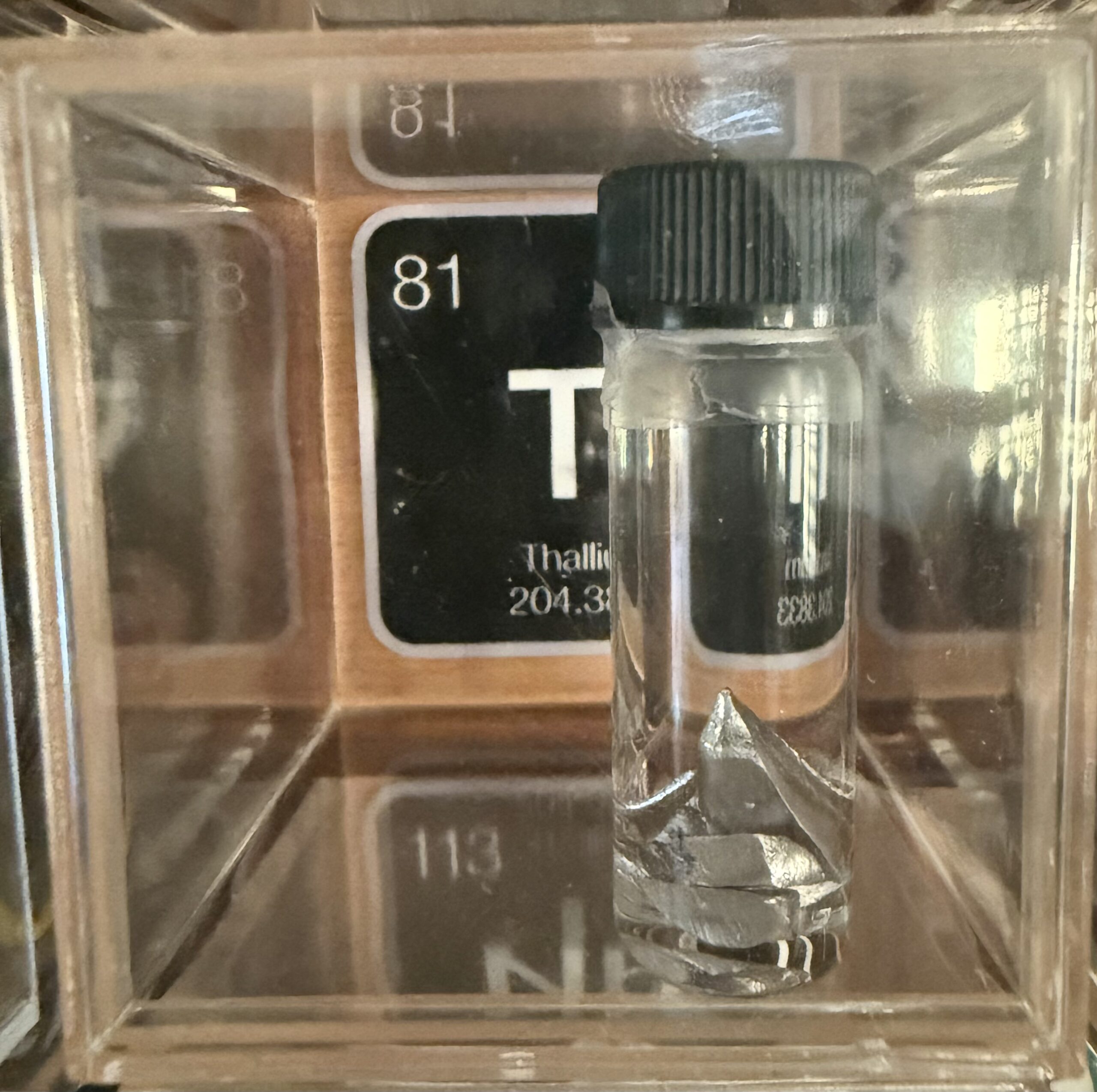Atomic Number: 81
Atomic Mass: 204.38

Thallium may not be as well-known as gold or platinum, but this soft, silvery metal has carved out an important role in modern industries and scientific research. Despite its notorious toxicity, thallium has been critical in applications ranging from electronics to medicine. In this blog post, we will explore the discovery of thallium, its unique properties, and how it is used today.
The Discovery of Thallium
Thallium was discovered by British chemist Sir William Crookes in 1861. Crookes was investigating residues from sulfuric acid production using spectroscopy, a technique that analyzes light emitted by elements. He noticed a bright green spectral line, which indicated the presence of an unknown element. This green line led Crookes to name the element “thallium,” derived from the Greek word thallos, meaning “green shoot” or “twig,” due to the color of its spectral emission.
Just a year later, in 1862, French chemist Claude-Auguste Lamy independently discovered and isolated thallium in its pure form. Both scientists contributed to the early research on this new element, but it was Crookes who first identified it spectroscopically.
Properties of Thallium
Thallium (chemical symbol Tl) is a soft, malleable metal that can be easily cut with a knife. It has a melting point of 304°C and a boiling point of 1,473°C. Although thallium initially resembles lead in appearance, it quickly tarnishes when exposed to air, forming a grayish oxide layer.
One of the most significant properties of thallium is its extreme toxicity. It can be absorbed through the skin, ingested, or inhaled, leading to severe health effects such as nerve damage, hair loss, and organ failure. Thallium has been notoriously used as a poison in criminal cases, giving it a dark history in addition to its industrial uses.
Modern-Day Uses of Thallium
Despite its toxicity, thallium has several important applications in modern industries and scientific research. These include:
1. Electronics and Semiconductors
Thallium’s conductivity properties make it valuable in the electronics industry, particularly in the production of semiconductors. Thallium-based compounds are used in photocells, infrared detectors, and certain types of high-temperature superconductors.
2. Optics and Glass Manufacturing
Thallium is used in specialized glass manufacturing, particularly in lenses and optical components that require a high refractive index. Thallium oxide is added to glass formulations to improve its clarity and optical properties. This makes it useful in scientific instruments, optical lenses, and prisms.
3. Medicine
Thallium plays a surprising role in medical diagnostics. A radioactive isotope of thallium, thallium-201, is used in nuclear medicine for stress tests to diagnose heart disease. During a thallium scan, the isotope is injected into the bloodstream, and a special camera detects the radiation emitted as the thallium circulates through the heart, helping doctors assess blood flow and heart function.
However, due to its toxicity, thallium has been largely replaced by safer alternatives in other areas of medicine.
4. Rat Poison and Pesticides (Historical Use)
Thallium was once widely used in rat poison and insecticides due to its lethal nature. However, this practice has been banned in many countries due to the severe health risks posed to humans and wildlife. Today, the use of thallium in pesticides has been greatly restricted, and safer alternatives have replaced it.
5. Research and Chemistry
Thallium compounds are used in chemical research and laboratory settings. They serve as catalysts in organic reactions and are used in the study of chemical bonding and molecular structures. Thallium salts have been employed in biological studies, particularly in tracing the movement of ions through biological membranes.
Health and Environmental Concerns
Thallium’s toxic nature makes it a significant health and environmental hazard. Prolonged exposure to thallium, either through ingestion or skin contact, can result in severe poisoning. The symptoms of thallium poisoning include hair loss, gastrointestinal distress, nerve damage, and death in severe cases.
Because of its toxicity, strict regulations are in place to limit thallium’s use in industrial processes and to manage its disposal. Thallium contamination in the environment can result from mining activities or improper disposal of electronic waste, making it a focus of environmental safety efforts.
The Future of Thallium
As technology advances, the role of thallium in electronics, optics, and medical diagnostics may evolve. However, its toxic nature has spurred the development of alternative materials that can perform similar functions without posing the same risks. As industries move toward more sustainable and safer practices, thallium’s use in certain fields may continue to decline, although its critical role in specific applications, like heart disease diagnostics and high-tech materials, will likely endure.
Conclusion
Thallium’s fascinating history, from its discovery by spectroscopy to its modern-day uses, highlights the dual nature of many chemical elements. While it is extremely toxic and dangerous in many forms, thallium’s unique properties have also made it valuable in technology, optics, and medicine. As we continue to balance the benefits of thallium with its hazards, this element remains a reminder of the complexity and duality of the natural world.
 using WordPress and
using WordPress and
Comments are closed